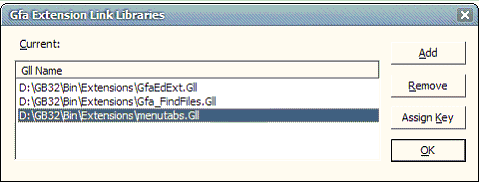
Before the editor extension can be used, it must be installed using the Extension Manager (in German "Gll Laden+Config") which you can find in the Extra submenu.

The Extension Manager is a dialog box named "Gfa Extension Link Libraries" and shows the currently loaded GLLs. They are displayed in the order they are loaded.
To install a new GLL select the Add (or in German "Hinzufügen") button and select the required GLL from the File Open dialogbox. As soon as the GLL is added, it is loaded into memory and, when available, the Gfa_Init sub is executed.
At this point, the installation is not yet complete, though. The keyboard shortcuts that the editor extension wants to use, must be activated. This means that the keyboard shortcut the extension wants to use must be assigned to that sub. By naming the sub Gfa_App_2 we want to execute the sub App + 2 is pressed, but what if this shortcut is already in use by a previously loaded GLL? In that case, we must assign another keyboard shortcut to the Gfa_App_2 subroutine.
The editor extension remains active until it is removed. To remove a GLL use the Extension Manager and choose Remove ("Entfernen"). Before the GLL is unloaded, the Gfa_Exit sub is executed. This provides the opportunity to cleanup resources the GLL used.
After an editor extension is successfully added to the IDE (installed), it is entered in the registry in HKCU\Software\GFA\Basic section. The next time GFA-BASIC 32 is started all editor extensions that are present in the registry are loaded automatically. They are loaded in the order as they are displayed in the Extension Manager dialog.
i When a GLL behaves badly when GFA-BASIC 32 starts, you might want to remove it from the registry. The GLL keys are named "Gll1", "Gll2", etc.
{Created by Sjouke Hamstra; Last updated: 12/05/14 by James Gaite}